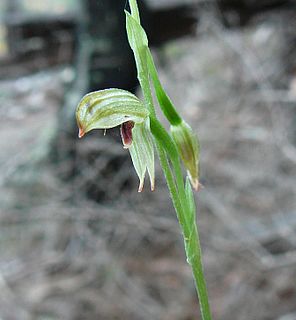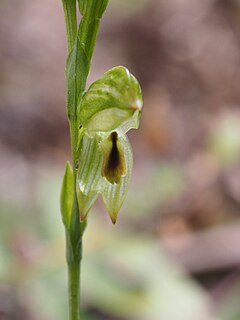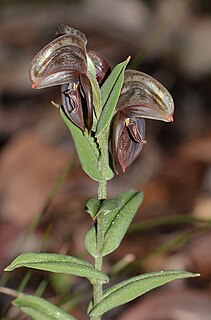
Pterostylis coccina, commonly known as the scarlet greenhood, is a species of orchid endemic to eastern Australia. As with similar greenhoods, the flowering plants differ from those which are not flowering. The non-flowering plants have a rosette of leaves flat on the ground but the flowering plants have a single flower with leaves on the flowering spike. In this species, the rosette leaves are relatively large and dark green, and the flowers are white, and bluish-green or red. It grows in New South Wales and north-eastern Victoria.

Pterostylis curta, commonly known as the blunt greenhood, is a species of orchid found in south-eastern Australia, Lord Howe Island and New Caledonia. It has a rosette of leaves at its base and a single white and green, forward leaning flower with a brown tip and a twisted labellum.

Pterostylis atrans, commonly known as the dark-tip greenhood or blunt-tongue greenhood, is a species of orchid endemic to south-eastern Australia. As with similar greenhoods, plants in flower differ from those that are not flowering. The non-flowering plants have a rosette of leaves flat on the ground, but the plants in flower have a single flower with leaves on the flowering spike. In this species, the flower is green and reddish brown with a protruding sinus and small club-like tips on the ends of the lateral sepals.

Pterostylis diminuta, commonly known as the small-flowered leafy greenhood, is a plant in the orchid family Orchidaceae and is endemic to Victoria. As with similar greenhoods, the flowering plants differ from those that are not flowering. The non-flowering plants have a rosette of leaves flat on the ground but the flowering plants have up to twelve small, partly green, partly translucent flowers and lack a rosette.

Pterostylis tunstallii, commonly known as Tunstall's greenhood or granite greenhood is a plant in the orchid family Orchidaceae and is endemic to south-eastern Australia. Flowering plants have up to ten transparent green flowers which have a dark brown, insect-like labellum with a blackish "head". Non-flowering plants have a rosette of leaves on a short stalk but flowering plants lack the rosette, instead having five to eight stem leaves.

Pterostylis laxa, commonly known as the antelope greenhood, is a species of orchid endemic to south-eastern Australia. As with similar greenhoods, the flowering plants differ from those which are not flowering. The non-flowering plants have a rosette of leaves flat on the ground but the flowering plants have a single flower with leaves on the flowering spike. This greenhood has green and white flowers with darker green or brown markings and a dorsal sepal with a long thread-like tip.
Pterostylis alata, commonly known as the striped greenhood, is a species of orchid endemic to Tasmania. As with similar orchids, the flowering plants differ from those which are not flowering. The non-flowering plants have a rosette of leaves but the flowering plants have a single flower with leaves on the flowering spike. This greenhood has a white flower with prominent dark green stripes and a sharply pointed, brown-tipped dorsal sepal. Similar greenhoods growing on the Australian mainland were formerly known as Pterostylis alata but are now given the name Pterostylis striata.
Pterostylis agathicola, commonly known as the kauri greenhood, is a species of orchid endemic to the North Island of New Zealand. As with similar greenhoods, the flowering plants differ from those which are not flowering. The non-flowering plants have a rosette of leaves flat on the ground but the flowering plants have a single flower with leaves on the flowering spike. It grows almost exclusively in kauri forest and has a relatively large green and transparent white flower.
Pterostylis aphylla, commonly known as the leafless greenhood, is a species of orchid endemic to Tasmania. As with similar greenhoods, the flowering plants differ from those which are not flowering. The non-flowering plants have a rosette of leaves flat on the ground but in this species, the flowering plants have a single green and white flower with a brown tip and lack leaves apart from a few small scales.

Pterostylis barringtonensis, commonly known as the Barrington leafy greenhood, is a plant in the orchid family Orchidaceae and is endemic to New South Wales. As with similar greenhoods, the flowering plants differ from those which are not flowering. The non-flowering plants have a rosette of leaves on a short stalk but the flowering plants lack a rosette and have up to seven dark green flowers on a flowering stem with stem leaves. It is only known from Barrington Tops.
Pterostylis bicornis, commonly known as the horned greenhood, is a plant in the orchid family Orchidaceae and is endemic to eastern Australia. Non-flowering plants have a rosette of leaves while flowering plants have a similar rosette at the base of a flowering spike with a one or two dark green, white and brown flowers. The flowers have distinctive long, thin horn-like tips.
Pterostylis cernua, commonly known as the Westland greenhood, is a species of orchid endemic to New Zealand. Non-flowering plants have a rosette of leaves but flowering plants have a single white, dark green and reddish-brown flower with leaves on the flowering stem.

Pterostylis concava, commonly known as the pouched greenhood or cupped banded greenhood, is a plant in the orchid family Orchidaceae and is endemic to the south-west of Western Australia. The plants either have a rosette of leaves in the years when not flowering or stem leaves on a flowering spike. When flowering, it has up to ten or more flowers which are dark reddish-brown, sometimes green and white with deeply cupped lateral sepals. It is an uncommon orchid, mostly found between Bindoon and Mount Barker.
Pterostylis paludosa, commonly known as swamp greenhood, is a species of greenhood orchid endemic to New Zealand. As with similar orchids, plants in flower differ from those that are not. Those not in flower have a rosette of leaves on a short stalk but plants in flower lack a rosette and have a single flower with leaves on the flowering spike. This greenhood has a translucent white flower with pale to yellowish-green stripes.
Pterostylis procera, commonly known as the short-lipped greenhood, is a species of orchid endemic to Queensland. It has a rosette of leaves and when flowering a single translucent white flower with green and reddish markings and a labellum which does not protrude through the lateral sepals.
Pterostylis riparia, commonly known as the streamside greenhood, is a plant in the orchid family Orchidaceae and is endemic to New South Wales. Both flowering and non-flowering plants have a rosette of dark green, fleshy leaves. Flowering plants have a single, relatively large green, white and reddish-brown flower with a deeply notched sinus between hairy lateral sepals.

Pterostylis roensis, commonly known as the painted rufous greenhood or dark rustyhood is a plant in the orchid family Orchidaceae and is endemic to the south-west of Western Australia. Both flowering and non-flowering plants have a relatively large rosette of leaves. Flowering plants also have up to six green or brown to blackish flowers with translucent white panels and a dark brown, fleshy, insect-like labellum.

Pterostylis torquata, commonly known as the collared greenhood, is a species of orchid endemic to New South Wales. As with similar greenhoods, the flowering plants differ from those which are not flowering. The non-flowering plants have a rosette of leaves flat on the ground but the flowering plants have a single flower with leaves on the flowering stem. This greenhood has a white flower with dark green and dark brown markings, although in some areas, the flowers lack the brown markings. The sinus between the lateral sepals is platform-like.
Pterostylis uliginosa, commonly known as the marsh greenhood, is a species of orchid endemic to south-eastern Australia. As with similar orchids, the flowering plants differ from those which are not flowering. The non-flowering plants have a rosette of leaves but the flowering plants lack a rosette at the base but have up to three rosettes on lateral growths and up to seven small green and white flowers. This species only grows in wet places, usually where there is free water. There are usually only two or three flowers per plant, and only one or two are open at a time.

Pterostylis umbrina, commonly known as the broad-sepaled leafy greenhood, is a plant in the orchid family Orchidaceae and is endemic to the Australian Capital Territory and New South Wales on the Southern Tablelands. As with similar greenhoods, plants in flower differ from those that are not. Those not in flower have a rosette of leaves flat on a short stalk. Plants in flower have up to six green flowers with darker green stripes with stem leaves but lack a rosette.










